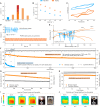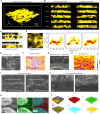Permeable void-free interface for all-solid-state alkali-ion polymer batteries
- PMID: 39423265
- PMCID: PMC11488535
- DOI: 10.1126/sciadv.adr9602
Permeable void-free interface for all-solid-state alkali-ion polymer batteries
Abstract
All-solid-state batteries suffer from a loss of contact between the electrode and electrolyte particles, leading to poor cyclability. Here, a void-free ion-permeable interface between the solid-state polymer electrolyte and electrode is constructed in situ during cycling using charge/discharge voltage as the stimulus. During the charge-discharge, the permeation phase fills the voids at the interface and penetrates the electrode, forming strong bonds with the cathode and effectively mitigating the contact problem. Our all-solid-state potassium ion polymer batteries maintain high Coulombic efficiency more than 2000 cycles at a high operating voltage of 4.5 volt and stably cycle more than 500 cycles even at 4.6 volt. Our rational design for mitigating the contact problem is versatile, as demonstrated by the scalability of all-solid-state graphite-based polymer potassium-ion pouch cells and all-solid-state lithium-ion polymer batteries.
Figures





Similar articles
-
Multiple Dynamic Bonds-Driven Integrated Cathode/Polymer Electrolyte for Stable All-Solid-State Lithium Metal Batteries.Angew Chem Int Ed Engl. 2023 Aug 28;62(35):e202307255. doi: 10.1002/anie.202307255. Epub 2023 Jul 21. Angew Chem Int Ed Engl. 2023. PMID: 37431962
-
Interfacial self-healing polymer electrolytes for Long-Cycle silicon anodes in High-Performance solid-state lithium batteries.J Colloid Interface Sci. 2024 Jul;665:299-312. doi: 10.1016/j.jcis.2024.03.118. Epub 2024 Mar 18. J Colloid Interface Sci. 2024. PMID: 38531275
-
Anion-modulated Ion Conductor with Chain Conformational Transformation for stabilizing Interfacial Phase of High-Voltage Lithium Metal Batteries.Angew Chem Int Ed Engl. 2024 May 6;63(19):e202317856. doi: 10.1002/anie.202317856. Epub 2024 Mar 28. Angew Chem Int Ed Engl. 2024. PMID: 38389190
-
Understanding and Engineering Interfacial Adhesion in Solid-State Batteries with Metallic Anodes.ChemSusChem. 2023 Jun 22;16(12):e202202215. doi: 10.1002/cssc.202202215. Epub 2023 Apr 19. ChemSusChem. 2023. PMID: 36892133 Free PMC article. Review.
-
Solid-State Lithium Metal Batteries with Extended Cycling Enabled by Dynamic Adaptive Solid-State Interfaces.Adv Mater. 2021 Mar;33(12):e2008084. doi: 10.1002/adma.202008084. Epub 2021 Feb 19. Adv Mater. 2021. PMID: 33604935 Review.
Cited by
-
Catalysis of a LiF-rich SEI by aromatic structure modified porous polyamine for stable all-solid-state lithium metal batteries.Chem Sci. 2025 Jan 8;16(5):2453-2464. doi: 10.1039/d4sc07449a. eCollection 2025 Jan 29. Chem Sci. 2025. PMID: 39790988 Free PMC article.
-
Facilitating uniform lithium-ion transport via polymer-assisted formation of unique interfaces to achieve a stable 4.7 V Li metal battery.Natl Sci Rev. 2025 May 10;12(6):nwaf182. doi: 10.1093/nsr/nwaf182. eCollection 2025 Jun. Natl Sci Rev. 2025. PMID: 40475066 Free PMC article.
-
A bismuth oxide-modified copper host achieving bubble-free and stable potassium metal batteries.Chem Sci. 2024 Dec 12;16(3):1344-1352. doi: 10.1039/d4sc07483a. eCollection 2025 Jan 15. Chem Sci. 2024. PMID: 39697420 Free PMC article.
References
-
- Mu J., Liao S., Shi L., Su B., Xu F., Guo Z., Li H., Wei F., Solid-state polymer electrolytes in lithium batteries: Latest progress and perspective. Polym. Chem. 15, 473–499 (2024).
-
- Yoon K., Lee S., Oh K., Kang K., Challenges and strategies towards practically feasible solid-state lithium metal batteries. Adv. Mater. 34, 2104666 (2022). - PubMed
-
- Lu Y., Li L., Zhang Q., Niu Z., Chen J., Electrolyte and interface engineering for solid-state sodium batteries. Joule 2, 1747–1770 (2018).
LinkOut - more resources
Full Text Sources

